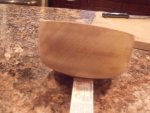You're making good progress.

I'll just echo what Ted and Ryan said. First, we're not even CLOSE to being bored.

Second, it will get easier as you do more, and especially if you go for a more curved/conical shape instead of the straight sides with a bottom transition.

Glad to see you're getting into some easier wood. It may not have seemed easy this time, but once you get the feel for the tool presentation, I think you'll agree that it's easier to get clean cuts in maple than pine. Based on your description, I'll also go with Ryan's guess that your gouge might not have been as sharp as it could have been. It's really hard to know what "sharp enough" feels like until you've actually felt it. (One good reason for joining a turning club and finding a buddy willing to mentor you for an afternoon.) As a general rule, anytime you feel like you're having to force or "push" the cut, chances are the tool's not sharp. In time, you'll learn how a sharp tool feels and how to get your tools that way.
To answer your bevel-riding question, for me it was another one of those "you'll know it when feel it" kind of things. I just kind of had an "a-ha" moment or two, and it all kind of clicked into place. I just now did a little TouTubing and found these videos (which you've quite possibly seen) that attempt to explain the concept:
An interesting way to demonstrate the bevel:
http://www.youtube.com/watch?v=GT1N8CXo6v0
Lyle Jamison doing a natural edge bowl, but his description and camera angles help explain the concept of riding the bevel:
[Oops...Ted beat me to it, lol.]










